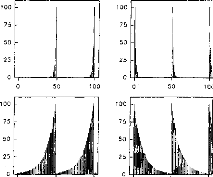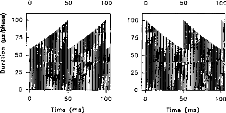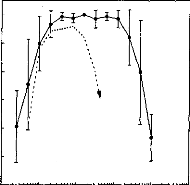Article 11 :
DISCRIMINATION OF TEMPORAL ASYMETRY IN COCHLEAR
IMPLANTEES
C. Lorenzi, S. Gallégo, R.D. Patterson
J. Acous. Soc. AM., 1997, 102(1), 482-485
L'objectif de cette étude a été
d'évaluer sur une population de 5 sujets implantés
cochléaires Digisonic, leur capacité de discrimination deux
enveloppes temporellement asymétriques. Les signaux utilisés
dérivent de l'étude de Patterson et al, 1994 effectuée
chez les normo-entendants et sont directement transmis au récepteur
interne via l'antenne sans passer par le processeur vocal.
Les résultats montrent que les sujets implantés
discriminent mieux les asymétries temporelles du signal que les sujets
normo-entendants. Cela pourrait être expliqué par l'absence de
lissage due à la biomécanique cochléaire lors d'une
stimulation électrique.
Discrimination of temporal asymmetry in cochlear
implantees
Christian Lorenzi
MRC, Applied Psychology Unit, 15 Chaucer Road, Cambridge CB2
2EF, United Kingdom and PCH Département de Psychologie Cognitive,
Institut de Psychologie, Université Lumière Lyon II,
69676 Bron Cedex, France
Stéphane Gallego
Laboratoire de Physiologie Sensorielle, "Perception &
Mécanismes Auditifs," UPRESA CNRS 5020, Pav. U. Hôpital E.
Herriot, 69437 Lyon Cedex 03, France
Roy D. Patterson
MRC, Applied Psychology Unit, 15 Chaucer Road, Cambridge CB2
2EF, United Kingdom
(Received 1 February 1996; revised 2 January 1997; accepted 2
April 1997)
Several studies have recently demonstrated that normal-hearing
listeners are sensitive to short-term temporal asymmetry in the envelopes of
sinusoidal or noise carriers. This paper presents a study in which cochlear
implantees were presented trains of current pulses with temporally asymmetric
envelopes through one channel of an implant that stimulates the auditory nerve
directly, thereby bypassing cochlear processes. When the level of the stimuli
was adjusted to fit their audibility range, the implantees were able to
discriminate temporal asymmetry over a much wider range than normal-hearing
listeners. The results suggest that the perception of temporal asymmetry is
limited by compression in the normal cochlea. (c) 1997 Acoustical Society
of America. [S0001-4966(97)06707-6]
PACS numbers: 43.66.Jh, 43.66.Mk, 43.66.Sr, 43.66.Ts [WJ]
INTRODUCTION
When a sound with an asymmetric temporal envelope is reversed
in time, it often produces a marked change in the timbre of the sound. The
effect is important because the power spectrum of a sound does not vary with
the time reversai. Although the perceptual effect of the time reversai is
well-known, it was largely ignored until recently, when Patterson (1994a, b)
showed how the effects of the time reversai could be studied systematically
using "damped" and "ramped" sinusoids. The term "damped sinusoid" refers to a
segment of a sinusoid with a damped exponential envelope that is repeated
cyclically to produce a sustained sound. The "ramped sinusoid" is simply the
damped sinusoid reversed in time. The envelope "damps" down in the former case
and "ramps" up in the latter case. Normal-hearing listeners can discriminate
damped sinusoids from ramped sinusoids when the half-life of the envelope is in
the range 1-50 ms. Compression in the cochlea of the normal-hearing listener
reduces the dynamic range of damped and ramped sinusoids in the neural
representations flowing from the cochlea. This led to the intriguing suggestion
that cochlear implantees might exhiba even better asymmetry discrimination than
normalhearing listeners because the implant bypasses the cochlea and any
compression it might impose. We assume, as argued by Shannon (1986), that
sensitivity to level differences in the central auditory system of cochlear
implantees is about the same as that for normals when presented at the same
sensation level. It is also the case that with implantees, one can restrict the
stimulation to a single electrode and thereby preclude spectral cues to a
degree that is not possible with normal listeners. Thus cochlear implantees
would appear to pro- vide us with a unique opportunity to investigate the
limits of retrocochlear processing of temporal asymmetry.
There have been several demonstrations that cochlear
implantees can process temporal envelope information. Hochmair and
Hochmair-Desoyer (1984) reported that implantees could distinguish among
square, triangle, and sine waves for repetition frequencies up to 400 Hz.
Shannon (1986) demonstrated near normal temporal integration, gap detection,
and forward masking in two implantees, and more recently, Shannon (1992)
reported that implantees could detect amplitude modulation at least as well as
normal-hearing listeners. In these experiments, however, there is no
manipulation of temporal asymmetry.
I. EXPERIMENT
Pairs of ramped and damped envelopes with the same half-life
were presented to cochlear implantees to assess their discrimination of
temporal asymmetry. The electrical signal was delivered directly to a single
electrode of a Digisonic DX10 implant without going through the preprocessor to
avoid the compression normally applied by the device.
A. Method
Five postlingually deaf listeners (SP, BM, LR, FJ, BR)
participated in the experiment. Clinical information about these patients is
presented in Table I. They were ail implanted with a Digisonic DX10 device
(MXM), which is a transcutaneous 15-channel cochlear implant with an
intracochlear electrode array (Beliaeff et al., 1994). Activation was
limited to the most basal electrode which delivered biphasic current pulses;
the remaining 14 electrodes in the array were connected together to serve as
the return path for the current
|
Age
Patient (years)
|
Cause
of
deafness
|
Duration of
implant
use
(months)
|
Pulse amplitude (V)
|
Min Max
(us/phase) (,us/phase)
|
2
a
C
|
|
BM
|
64
|
head trauma
|
7
|
1.5
|
12
|
55
|
|
|
SP
|
44
|
head trauma
|
6
|
1.3
|
14.5
|
45
|
|
|
LR
|
60
|
unknown
|
3
|
1.3
|
10
|
45
|
|
|
FJ
|
45
|
head trauma
|
48
|
1.6
|
25
|
95
|
|
|
BR
|
36
|
progressive deafness
|
1
|
1.3
|
10
|
40
|
ri
a
|
|
|
|
|
|
|
|
C
o
o
|
TABLE I. Clinical data for the five cochlear implantees of the
study.
("common ground" mode of stimulation). X-ray photographs
revealed that electrode positioning was roughly the same for all implantees.
All stimuli were presented directly to the implanted electrode without going
through the speech processor. For each implantee, the pulse amplitude was fixed
and the pulse duration was adjusted from threshold (min) to comfort level
(max); the pulse amplitude and the min and max values for each implantee are
presented in Table I. All implantees were experienced in two-interval,
two-alternative forced choice tasks (21, 2AFC).
1. Stimuli
The stimuli were trains of biphasic current pulses of fixed
amplitude. The pulse duration as a function of time was shaped by a ramped or
damped function. Equation (1) shows the general foret of a damped envelope:
damp( t )= min + [max -- min]exp[c t/h1] ( 0 < t
< T),
(1)
hl is the half-life of the damped envelope, and c is
a constant (-0.693 147), that brings the envelope to [max --Inin]/2 in hl ms.
T is the repetition period which is 50 ms. The pulse rate was 800 Hz,
which was the maximum pulse rate provided by the device used to perform direct
stimulation. The ramped envelopes were produced by reversing the damped
envelopes in time. The envelopes were digitally generated on a PC by a 16-bit
D/A converter at a sampling frequency of 44.1 kHz. The electrical stimuli were
generated using a Digistim system (MXM) connected to the PC via a serial port.
The duration of the stimuli was 500 ms; the silent interval between stimuli was
500 ms. The comfort level, max, was adjusted as the half-life was increased so
that the stimuli were of approximately equal loudness. The loudness of the
stimuli was equated by asking each implantee to adjust the level of each damped
stimulus to that of a damped stimulus with a 8-ms half-life. Adjustment was
performed using an initial step size

0
o
10
50
10
100
75 -
50
25 -
11111111..,.
100
75
50
25
0
100 75 50 25
o
lÎ
L IL
100
75
50
25
0 rmeitil

o
50
100
o
5
100
0 50
Time (ms)
100
î 100
g 75
C
uc=, 50
0 25
o
FIG. 1. Ramped (left column) and damped (right column) current
pulse trains with a half-life of 1 ms (top section), 8 ms (middle section), and
64 ms (bottom section). The carrier frequency is 800 Hz. The repetition period
is 50 ms.
of 5us/phase and a final step size of 0.5 ,us/phase. Three
estimates were collected and averaged. The average max values measured for each
half-life and for each implantee are presented in Table II.
Segments of the current pulse trains are presented in Fig. 1;
the left and right panels show ramped and damped fonctions, respectively. The
half-life of the exponential is 1 ms in the top section, 8 ms in the middle
section, and 64 ms in the bottom section of Fig. 1. The trains of current
pulses show that the Digistim system preserves the temporal envelope.
2. Procedure
Implantees sat in front of a keyboard connected to the
computer controlling the experiment. The task was 21, 2AFC. In a given trial,
implantees were presented a ramped stimulus in one interval and a damped
stimulus with the same half-life in the other interval, and asked to choose the
interval with the "more tonal quality." In each trial, inter-
TABLE II. Max values (in ms/phase) producing stimuli of equal
loudness as the half-life is increased from 0.25 to 1024 ms. The data are
presented for the five cochlear implantees of the study.
|
hl
(ms)
|
0.25
|
0.5
|
1
|
2
|
4
|
16
|
32
|
64
|
128
|
256
|
512
|
1024
|
|
BM
|
65
|
60
|
60
|
60
|
55
|
55
|
50
|
45
|
40
|
40
|
37
|
40
|
|
SP
|
53
|
52.5
|
50
|
48
|
46.5
|
44
|
43
|
42
|
41
|
40
|
38
|
37.5
|
|
LR
|
38
|
40
|
41
|
43
|
45
|
45
|
45
|
45
|
40
|
37
|
35
|
35
|
|
FI
|
80
|
86.5
|
90
|
90
|
95
|
95
|
85
|
77
|
71
|
65.5
|
67
|
65
|
|
BR
|
35
|
35
|
35
|
37
|
42.5
|
36
|
31.5
|
30
|
27.5
|
23
|
23
|
23
|

100
90
80
8
.g 70 2
60
50
40
0.1 10 100 1000 10000
Half-life (ms)
FIG. 2. Average psychometric function for the five cochlear
implantees, showing performance as a function of hl. Error bars show one
standard deviation about the mean performance of the five implantees. For
comparison, the data are piotted along with the mean of the data obtained with
normal-hearing listeners.
vals were presented in random order. A correct response
corresponded to a ramped response. The half-life was fixed within a block and
was varied from 0.25 to 1024 ms from block to block. Each block contained 30
trials. Implantees received visual feedback conceming the accuracy of their
response after each trial. They received 15 min of preliminary training before
participating in the experiment.
B. Results
The average psychometric function for the five implantees is
presented by the solid line with filled circles in Fig. 2. The dotted line
without symbols show the mean of the data obtained by Patterson (1994b) and
Irino and Patterson (1996) with normal-hearing listeners, using a carrier
frequency of 800 Hz and a repetition rate of 50 ms. The results show that
implantees can discriminate ramped and damped envelopes better than
normal-hearing listeners. Performance is above chance for half-lives as short
as 0.5 ms and as long as 500 ms; the range for normal-hearing listeners is
about 1-50 ms. The individual psychometric functions were very similar in shape
to that of the average psychometric function. Table III
TABLE III. Short threshold half-life and long threshold
half-life for the five cochlear implantees. The number of doublings between the
short and long thresholds half-lives is presented in the last column.
|
Patient
|
Shortest hl
(ms)
|
Longest hl
(ms)
|
Number of
doublings
|
|
BM
|
0.57
|
610
|
10.06
|
|
SP
|
0.9
|
780
|
9.75
|
|
LR
|
0.2
|
300
|
10.55
|
|
FJ
|
0.69
|
860
|
10.28
|
|
BR
|
0.4
|
460
|
10.16
|
presents estimates of the shortest and the longest
justdiscriminable half-lives for the individual psychometric functions, and it
shows that the short and long thresholds covary. The number of doublings
between the short and long threshold is presented in the right-hand column; it
is close to ten for all of the implantees indicating that the size of the range
where discrimination is possible is highly consistent across implantees.
II. DISCUSSION AND CONCLUSIONS
When damped and ramped envelopes with the same half-life are
presented to cochlear implantées at the optimum intensity and without
compression, they can discriminate the temporal asymmetry over a much broader
range of half-lives than normal-hearing listeners. The stimulation was
restricted to a single electrode, thereby precluding the use of spectral cues.
As stimuli were equated in loudness, it is also unlikely that loudness cues
played a role in the discrimination task. Discrimination at the shortest
half-lives may have been limited by the pulse rate of the Digistim device, 800
Hz, so envelopes with half-lives less than 1.25 ms would not be properly
represented. However, extension of the discrimination range to shorter
half-lives would only strengthen the conclusion.
The obvions explanation for the superior discrimination
performance of the hearing-impaired listeners would appear to be that
compression in the normal cochlea reduces sensitivity to level differences, and
temporal asymmetry is encoded as differences in level differences. Without
compression, and assuming the same level processing mechanism in the central
auditory system, hearing-impaired listeners are operating on larger level
differences and so do better, but of course, only within their much reduced
dynamic range. This is consistent with Shannon's (1992) finding that implantees
often exhibit greater sensitivity to amplitude modulation than normal-hearing
listeners when the modulation rate is less than 300 Hz.
Implantees cannot discriminate temporal pitch above 300 Hz
(Tong et al., 1982). All the implantees who participated in the
presented study labeled ramped stimuli as "smooth," "uniform," or "continuous,"
and damped stimuli as "interrupted" or "with a drum-like quality." This
suggests that the "tonal quality" used to instruct listeners was interpreted by
implantees as a "smooth quality."
Finally, the results indicate that it is important to ensure
that hearing aids and cochlear implants do not restrict temporal asymmetry
unduly when applying compression to control level. Asymmetry is a prominent
property of speech sounds and hearing-impaired listeners are likely to make
good use of it when it is available.
ACKNOWLEDGMENTS
The first author was supported by a post-doctoral grant from
the FYSSEN Foundation. The second author was supported by a CIFRE doctoral
grant from the MXM Company. We wish to thank two anonymous reviewers for
extensive comments on earlier versions of the paper.
Beliaeff, M., Dubus, P., Leveau, J. M., Repetto, J. C., and
Vincent, P. (1994). "Sound processing and stimulation coding of DIGISONIC DX10
15-channel cochlear implant," in Advances in Cochlear Implant, edited
by E. S. Hochmair (Vienna, Manz), pp. 198-203.
Hochmair, E. S., and Hochmair-Desoyer, I. J. (1984). "Aspects
of sound signal processing using the Vienna intra- and extracochlear implants,"
in Cochlear Implants, edited by R. A. Schindler and M. M. Merzenich
(Ras/en, New York), pp. 101-110.
Irino, T., and Patterson, R. D. (1996). "Temporal asymnetry in
auditory perception and a "delta-gamma" theory of asymmetric intensity
enhancement in the peripheral auditory system," J. Acoust. Soc. Am. 99,
23162331.
Patterson, R. D. (1994a). "The sound of a sinusoid: Spectral
models,"
J. Acoust. Soc. Am. 96, 1409-1418.
Patterson, R. D. (1994b). "The sound of a sinusoid:
Time-interval models," J. Acoust. Soc. Am. 96, 1419-1428.
Shannon, R. (1986). "Temporal processing in cochlear
implants," in Sensorineural Hearing Loss: Mechanisms, Diagnosis and
Treatment, edited by M. J. Collins, T. J. Glattke, and L. A. Harker
(University of Iowa, Iowa City), pp. 349-368.
Shannon, R. (1992). "Temporal modulation transfer functions in
patients with cochlear implants," J. Acoust. Soc. Am. 91, 2156-2164.
Tong, Y. C., Clark, G. M., Blamey, P. J., Busby, P. A., and
Dowell, R. C. (1982). "Psychophysical studies for 2 multiple-channel cochlear
implant patients," J. Acoust. Soc. Am. 71, 153-160.
L'article précédent démontre la grande
faculté des patients implantés à analyser l'enveloppe du
signal lors que l'on stimule directement le récepteur. Nous avons voulu
évaluer cette capacité de discrimination dans des conditions
réelles, avec le traitement du processeur vocal.
| 


